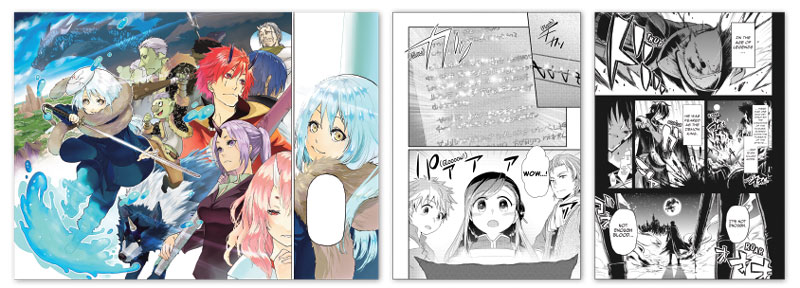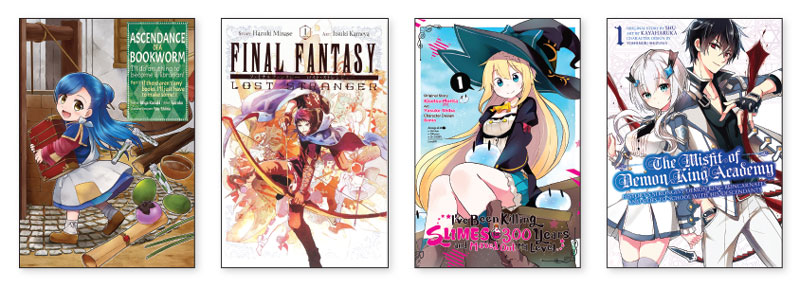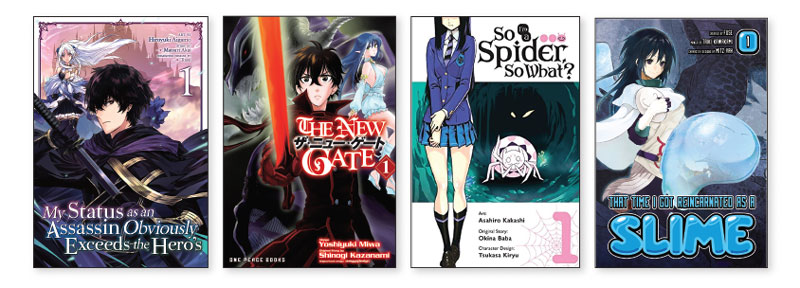Eight Essential Isekai Manga for Beginners | Mondo Manga
Isekai manga are some of the wildest fantasy stories on bookshelves right now. What are they? And which titles are must-haves for your collection?
 |
From the left: That Time I Got Reincarnated as a Slime.© Fuse, Taiki Kawakami/Kodansha Ltd.;Ascendance of a Bookworm. © Suzuka/Miya Kazuki;
|
Isekai manga are some of the wildest fantasy stories on bookshelves right now. Lengthy titles such as “I’ve Been Killing Slimes for 300 Years and Maxed Out My Level” or “We Swore To Meet in the Next Life and That’s When Things Got Weird” guide readers to stories in which the hero travels to a fantasy realm (the Japanese word isekai literally means “another world”). The hero usually dies at the beginning of the story and is reincarnated, or is transported through a portal, then builds skills and learns to navigate the new environment while embarking on quests. Yet these outlandish stories have a grassroots origin.
 “This type of isekai story became popular through web novel sites like Shosetsuka ni Narou, where lit-RPG (literary role-playing games) and fantasy with game-element stories became very popular approximately eight years ago,” says Samuel Pinarsky, president and founder of
“This type of isekai story became popular through web novel sites like Shosetsuka ni Narou, where lit-RPG (literary role-playing games) and fantasy with game-element stories became very popular approximately eight years ago,” says Samuel Pinarsky, president and founder of
J-Novel Club, which publishes light novels and manga digitally and in print. The web novels are written by amateurs and posted for free. Publishers began licensing them to be published as light novels (books that are meant to be quick reads with a few illustrations), which were then adapted into manga and anime, bringing the genre to new audiences and increasing its popularity. Pinarsky estimates that about 50 percent of the light novels published in Japan were originally web novels.
Pinarsky traces the popularity of the genre to “Sword Art Online,” a series of light novels, manga, and anime about a hero trapped inside a virtual reality video game; the story includes many of the tropes found in later isekai stories. (Yen Press publishes the “Sword Art Online” manga and novels in English.) While these series remain popular, most newer isekai have a different story line: The protagonist is transported to the vaguely medieval world used in fantasy novels and games, populated by creatures such as goblins, dragons, and demons, as well as by knights, adventurers, and royalty. They must learn the rules of the new world and accomplish heroic feats, often guided by a disembodied voice or visual cues, such as a stat sheet or menu, that provide information about the characters’ skills and abilities.
Manga critic Deb Aoki points out that isekai protagonists often come into their new existence with strong skills and abilities, unlike shonen manga heroes such as Naruto, who start out weak and build strength as the series progresses. “What they are usually weak in is human interaction skills,” she says, “so maybe that is the ‘character development’ difference here that is interesting to gamers, since the stereotype is that they’re socially inept in the ‘real world.’”
Often the heroes in isekai manga have unusually strong skills or memories from their previous life that give them an edge. While isekai have been criticized for this, many fans regard it as a plus. Pinarsky says that his readers look for stories that are fun and make them feel good. “Sometimes it can be where a main character uses their real-world knowledge to help a fantasy world, which makes the reader feel smart,” he says, “or sometimes it can be where a main character uses some special power to defeat a bad guy, which makes the reader feel special.”
“You could also make a larger societal argument that young people in Japan, not seeing the hope for the future in their own lives and world, are looking for stories about a world where they can make a difference/change, and succeed, rooted in systems they are already familiar with like online games,” says Pinarsky.
Aoki points out that the main characters in many isekai manga are young adults, not children or younger teenagers as in shonen manga. “If you think about it, isekai stories offer a bit of a release valve for Japanese readers who are used to being stuck in a fairly rigid life plan—school, college, a job you keep for most of your life that forces you to work long hours under an age-based company hierarchy,” she says.
Pinarsky believes that the titles are so long because of the format of the web novel site Shosetsuka ni Narou, which listed chapters by title only. “Authors found that if they didn’t put at least a good idea of what the content of the story was in the title itself, people wouldn’t actually click through to the summary page,” he said, “so titles gradually became longer and longer and more descriptive in a Cold War–style fight over the top ranking lists on Narou.”
“At this point,” he adds, “the long titles themselves are almost a part of web novel culture.”

Ascendance of a Bookworm. Miya Kazuki. illus. by Suzuka. J-Novel Club.
Gr 5 Up –A college girl who loves to read is crushed by her bookcases during an earthquake and comes back as Myne, a sickly little girl in a poor family. Worst of all, books are accessible only to the rich in this world, where the printing press hasn’t been invented yet, so Myne resolves to make her own books. This super-cute slice-of-life story doesn’t have any game features; it focuses on Myne (who has an adult’s intelligence) trying to make sense of her new world, and it’s a great choice for younger readers.
Final Fantasy: Lost Stranger. Hazuki Minase. illus. by Itsuke Kameya. Yen Pr.
Gr 8 Up –Shogo is a super Final Fantasy (FF) fan, so getting a job at parent company Square Enix seems like a dream come true. Unfortunately, he’s a lowly planner and doesn’t get to do much; his sister Yuko, who is in marketing, seems to be more successful. Then they get hit by a truck and are transported to the world of FF, or at least one version of it. Shogo’s observational skills serve him well, and the siblings team up with a group of adventurers who help them get oriented. When Yuko is killed by a monster, the stakes get higher, and Shogo and his companions must find a way to bring her back. While the story relies on FF characters and commands, there is enough context that non-gamers can enjoy it as well.
I’ve Been Killing Slimes for 300 Years and Maxed Out My Level. Kisetsu Morita. illus. by Yusuke Shiba & Benio. Yen Pr.
Gr 8 Up –Corporate drone Azusa literally dies of overwork, so when she is reincarnated, she wants to take it easy in the next life. She is reincarnated as a witch in a village straight out of an RPG, and she kills slimes (the lowest form of video game monster) to earn money. But after 300 years, her slime-killing stats are astronomical and she’s the most powerful witch in the area—and soon the locals are asking her for help or to be her disciple, shattering her peaceful existence. This cheerful story plays the situation mostly for laughs.
The Misfit of Demon King Academy. Shu. illus. by Kayaharuka & Yoshinori Shizuma. Square Enix Manga.
Gr 11 Up –In order to end a war between demons and humans, the Demon King of Tyranny, Anoth Voldigord, arranged to die and be reincarnated 2,000 years later. When he is reborn, he discovers that while humans and demons no longer seem to be fighting and have in fact interbred, their magic has deteriorated over the years. Anoth enrolls in Demon King Academy, which is designed to identify the reincarnated demon king—but his powers and knowledge are so off the charts that he can’t convince anyone of his true identity. While there’s some humor, this story has a fair amount of violence, hence the older age rating.

My Status as an Assassin Obviously Exceeds the Hero’s. Matsuri Akai. illus. by Hiroyuki Aigamo. Seven Seas.
Gr 8 Up –Akira’s class is transported to a fantasy world and asked by the king to defeat the demon king to save their realm. When they reveal their stats, though, Akira’s are the highest by far, and he hides so no one will know that. As an Assassin, he can conceal himself easily. Tsukasa, the golden boy of the class, is chosen as the hero who will lead the others in battle, but it quickly becomes clear that the king didn’t tell everyone the whole story, and only Akira is smart enough to be suspicious. This manga mixes gamelike elements with a genuine story of intrigue.
The New Gate. Yoshiyuki Miwa. illus. by Shinogi Kazanami. One Peace.
Gr 11 Up –This book begins with the end of an adventure: Shin slays the final boss and releases a group of players who were trapped inside a game. After they all log out, Shin finds he can’t leave. Not only has he stayed in the world of the game, he has moved 500 years into the future. Things have changed a lot, but he’s more powerful than most of the people he meets. Shin quickly makes friends and allies, but there’s a lot he doesn’t know about his new reality.
So I’m a Spider, So What? Okina Baba. illus. by Asahiro Kakashi. Yen Pr.
Gr 8 Up –An ordinary high school student dies in a catastrophe and wakes up as a spider. The story begins with her hatching from an egg, and from there she learns to assess her surroundings, spin webs, and fight other creatures for food and in self-defense, with help from video game–style text boxes. There’s plenty of monster-on-monster violence as she faces cannibalistic spiders, a basilisk, and more.
That Time I Got Reincarnated as a Slime. Fuse. illus. by Taiki Kawakami. Kodansha Comics.
Gr 11 Up –A salaryman dies at 37, still a virgin, while saving a coworker from a knife attack. He is reincarnated as a lowly slime, but as he levels up his skills he gradually gains more powers and becomes the leader of a goblin community, which in turn results in more adventures. Eventually, he gains the ability to take on human form, but he still often reverts to being a slime. This series has a strong mix of action and humor.
Brigid Alverson, editor of the “Good Comics for Kids” blog, writes Stellar Panels and Mondo Manga.
RELATED
The job outlook in 2030: Librarians will be in demand
The job outlook in 2030: Librarians will be in demand
ALREADY A SUBSCRIBER? LOG IN
We are currently offering this content for free. Sign up now to activate your personal profile, where you can save articles for future viewing





Add Comment :-
Be the first reader to comment.
Comment Policy:
Comment should not be empty !!!